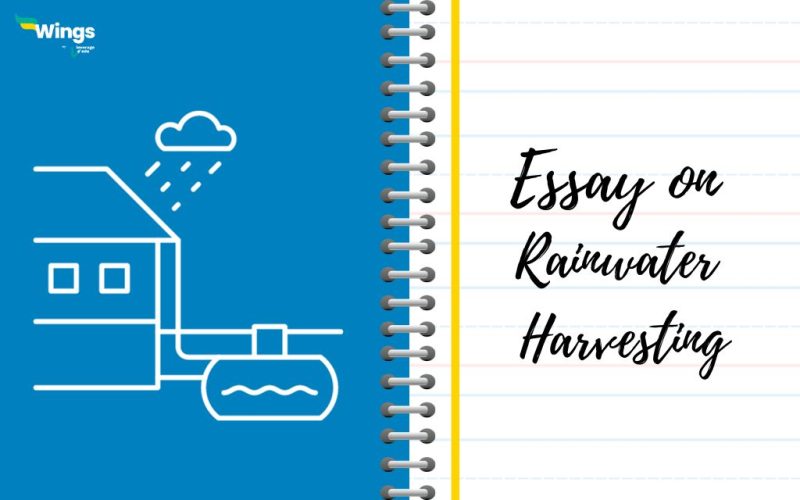Writing an essay on rainwater harvesting requires you to describe sustainable water management practices, such as the collection and storage of rainwater for various purposes, like irrigation, landscaping, domestic use, etc. In recent years, this technique has gained popularity as a way to conserve this life-saving resource and reduce the demand for traditional water sources like rivers, lakes, and groundwater.
Did you know that Earth is not the only planet where the phenomenon of rain occurs? Other celestial bodies, such as Saturn’s moon Titan, have rain, but it consists of liquid methane and ethane rather than water due to the extremely cold temperatures. Let’s check out some essays on rainwater harvesting for a better understanding of this topic.
Table of Contents
Also Read – Essay on Diwali
Essay on Rainwater Harvesting in 100 Words
Rainwater Harvesting (RWH) is the process of collecting and storing rainwater for various uses. This is an eco-friendly method to conserve rainwater resources for purposes like agricultural use, domestic use, etc. Rainwater can be collected on rooftops and other surfaces, filtered and stored in tanks or cisterns.
There are several benefits of rainwater harvesting, such as promoting water sustainability, lower water bills, environmental benefits by decreasing runoff and erosion, etc. Implementing rainwater harvesting systems is a step toward responsible water management, helping communities become more self-reliant in their water supply while protecting the planet’s clean water resources.
Essay on Rainwater Harvesting in 200 Words
Rainwater harvesting is one of the cost-effective ways to collect and store rainwater using different methods and techniques. In today’s world where fresh water is depleting at a tremendous rate, practising rainwater harvesting can be a vital strategy in the quest for responsible water management, conservation, and the promotion of sustainability.
Rainwater harvesting starts with the collection of rainwater on rooftops, pavements and other impermeable surfaces. To channel the rainwater into storage containers, gutters and downspouts are used. Rainwater can be stored in barrels or cisterns, depending on the resources available. Once collected, it can be used a various purposes such as irrigation, washing clothes, flushing toilets, and even for drinking, if treated properly.
Here are some of the compelling reasons stating the use of rainwater harvesting.
- This practice reduces the demand for natural water resources, such as surface water from rivers and groundwater.
- This can help to alleviate the stress on these limited or finite resources.
- It promotes water self-sufficiency and resilience, especially in drought-prone regions.
- Practising it at the domestic level can be an effective way to save money on water bills, especially for non-potable uses.
Due to climate change and water scarcity, practising rainwater harvesting can be an effective step for a sustainable and water-secure future.
Also Read – Essay on Technology
Essay on Rainwater Harvesting in 300 Words
One of the crucial and cost-effective ways to save water is to start practising rainwater harvesting. This age-old technique to conserve rainwater has gained significant popularity as the world is facing water scarcity, overuse of resources and environmental concerns. Rainwater can be collected on surfaces like impermeable rooftops, pavements or an open tank.
The collected rainwater can be channelled using gutters, and downspouts, where it can be stored in larger tanks or cisterns. This collected rainwater can be used for a multitude of applications, such as irrigation, flushing toilets, washing clothes, and even drinking after proper treatment.
There are several compelling reasons to embrace rainwater harvesting.
- Rainwater harvesting helps reduce the pressure on traditional water sources like rivers, lakes, and underground aquifers.
- Furthermore, it mitigates the risk of over-extraction, a critical concern in many regions.
- By harnessing rainwater, we can also build resilience against droughts and water shortages, ensuring a more reliable water supply.
- Rainwater harvesting is environmentally friendly, as it minimizes stormwater runoff, which can cause erosion, flood urban areas, and transport pollutants to water bodies.
- Instead, collected rainwater can be used to recharge local aquifers, promoting groundwater sustainability.
- Moreover, it curtails the energy and chemicals typically needed for water treatment and distribution in centralized water supply systems, reducing the carbon footprint.
From an economic perspective, rainwater harvesting can lead to significant savings on water bills, particularly for non-potable uses. It empowers individuals and communities to take control of their water supply, reducing their dependence on external sources.
However, successful rainwater harvesting requires thoughtful planning and investment. Proper filtration, treatment, and maintenance are essential to ensure the collected rainwater is safe and of good quality.
As the world faces mounting water challenges, its adoption is becoming increasingly critical. By integrating rainwater harvesting into our daily lives and infrastructure, we can take a significant step toward securing our water future while reducing our impact on the environment.
FAQs
Rainwater Harvesting is a sustainable water management practice, in which rainwater is collected and stored in tanks for various purposes. It’s one of the most eco-friendly ways to conserve water.
Some of the water conservation measures are: practising rainwater harvesting for non-profitable use, practising smart irrigation methods, installing low-flow faucets at home, reusing greywater for irrigation and toilet flushing, etc.
There are several ways in which rainwater can be collected. Installing rainwater collection surfaces like a roof or tarp, installing gutters and downspouts, and regularly checking and cleaning filters, screens, and storage containers to ensure the water remains clean and free from contaminants.
For more information on such interesting topics, visit our essay writing page and make sure to follow Leverage Edu.
 One app for all your study abroad needs
One app for all your study abroad needs













